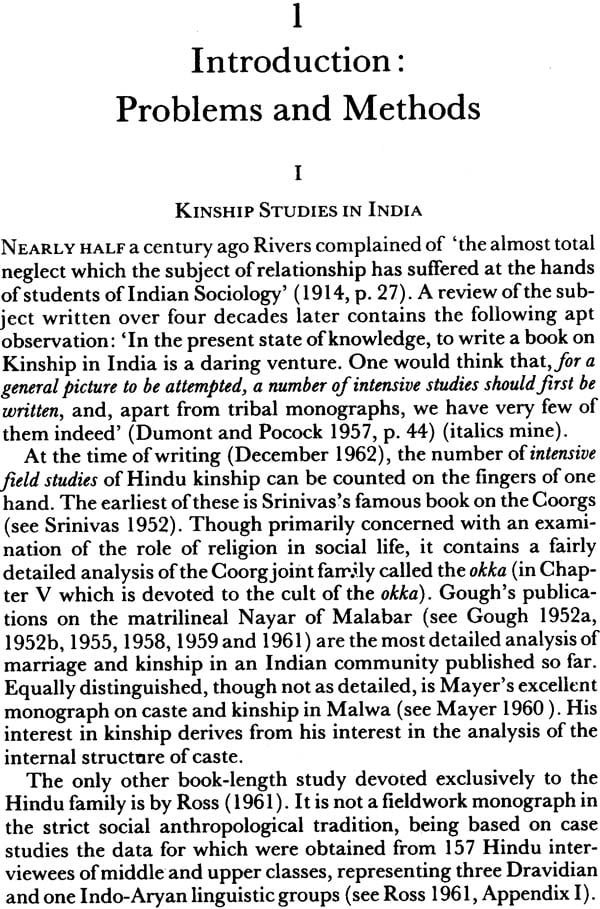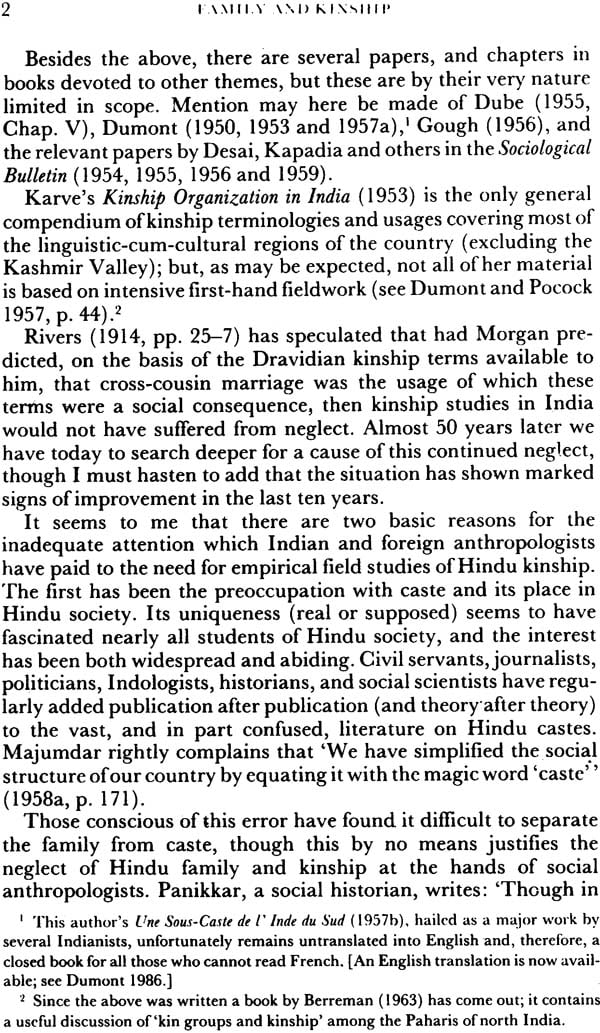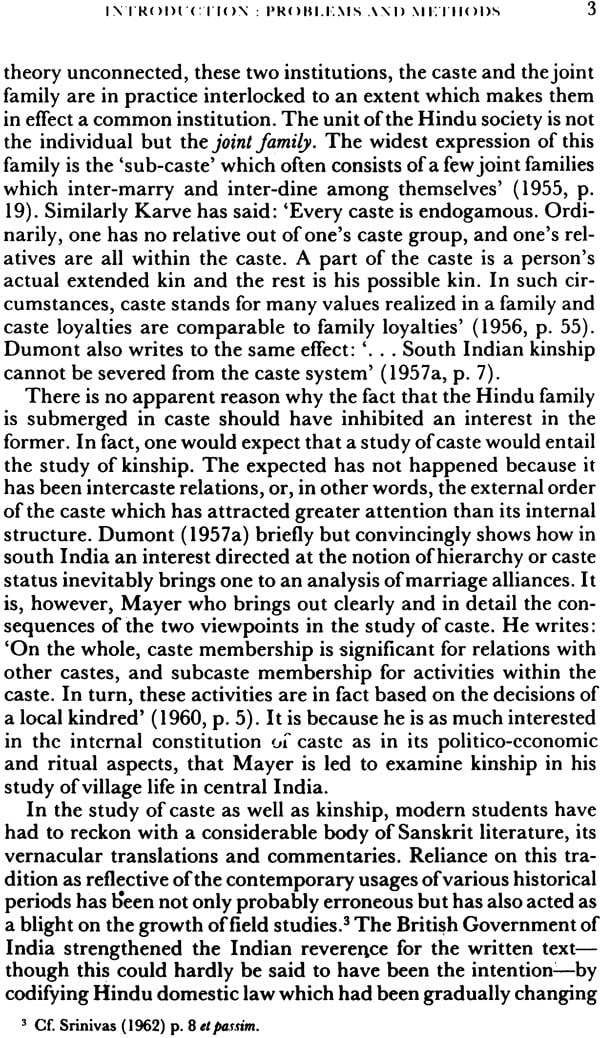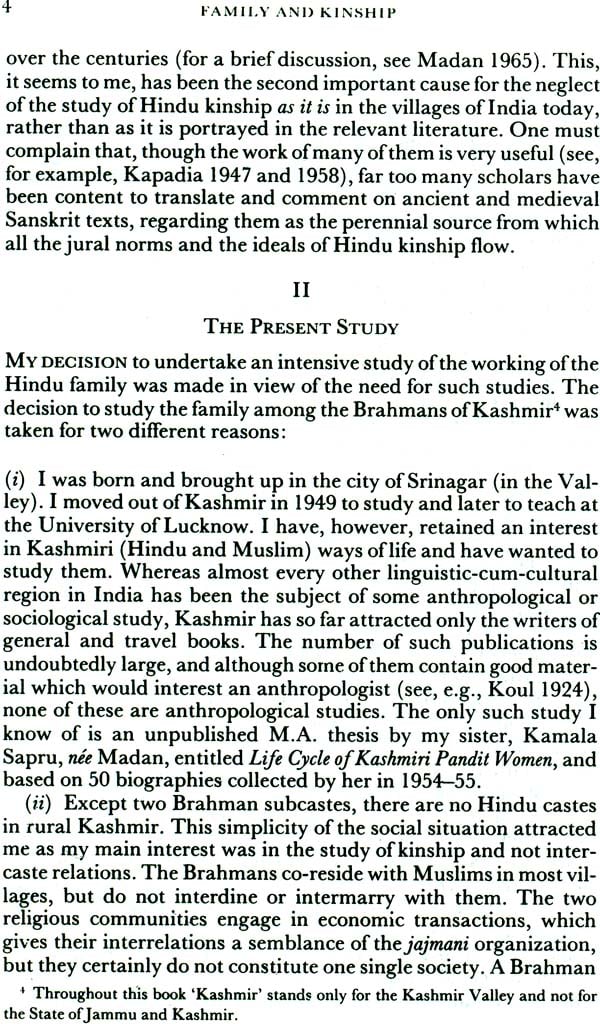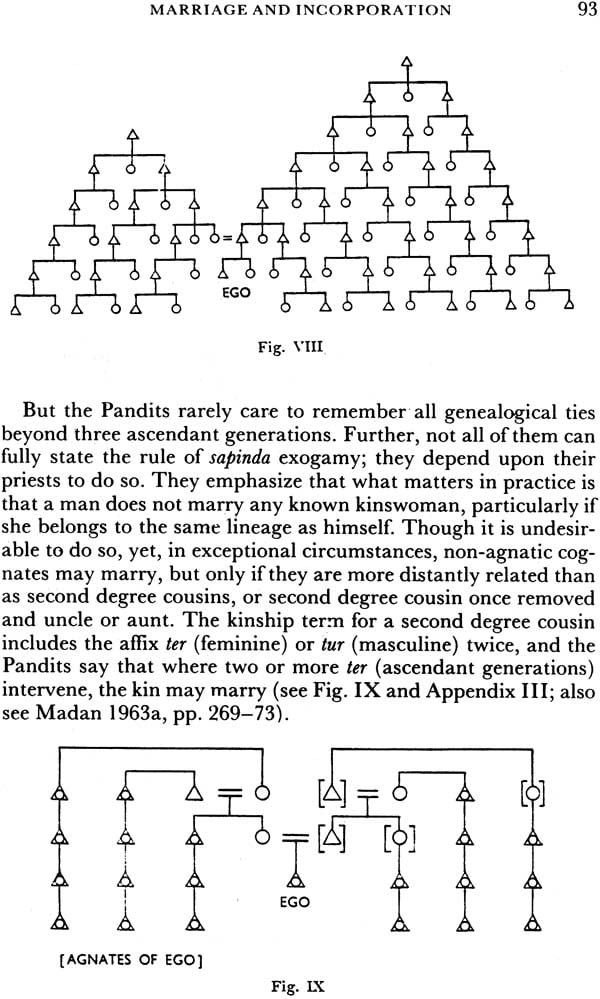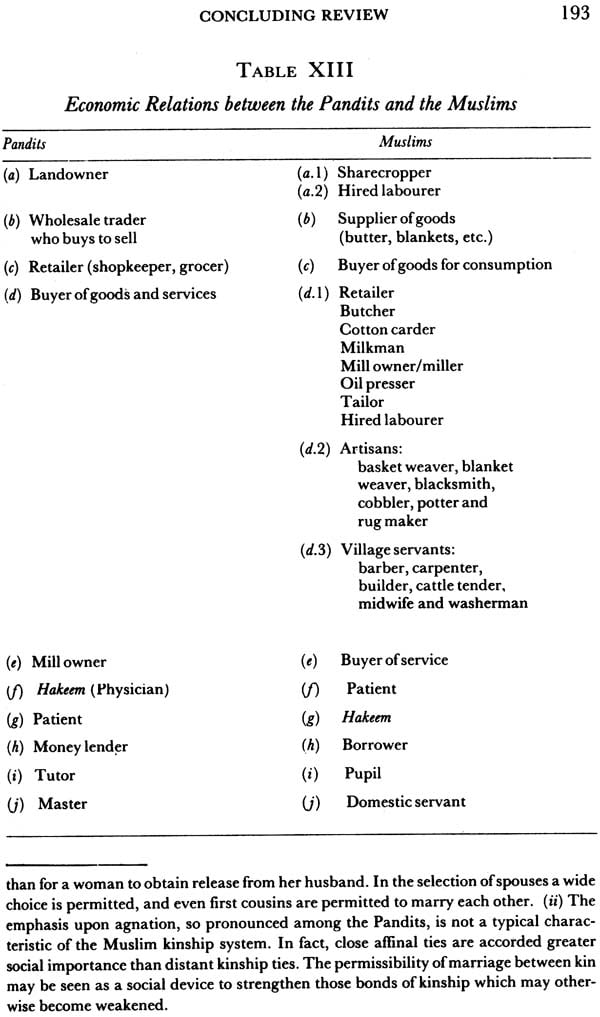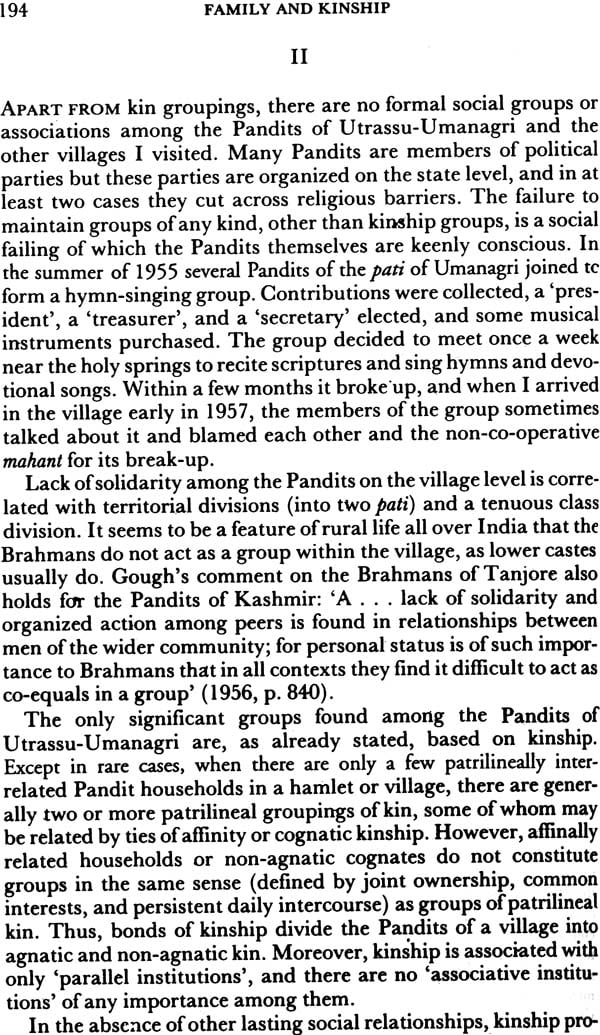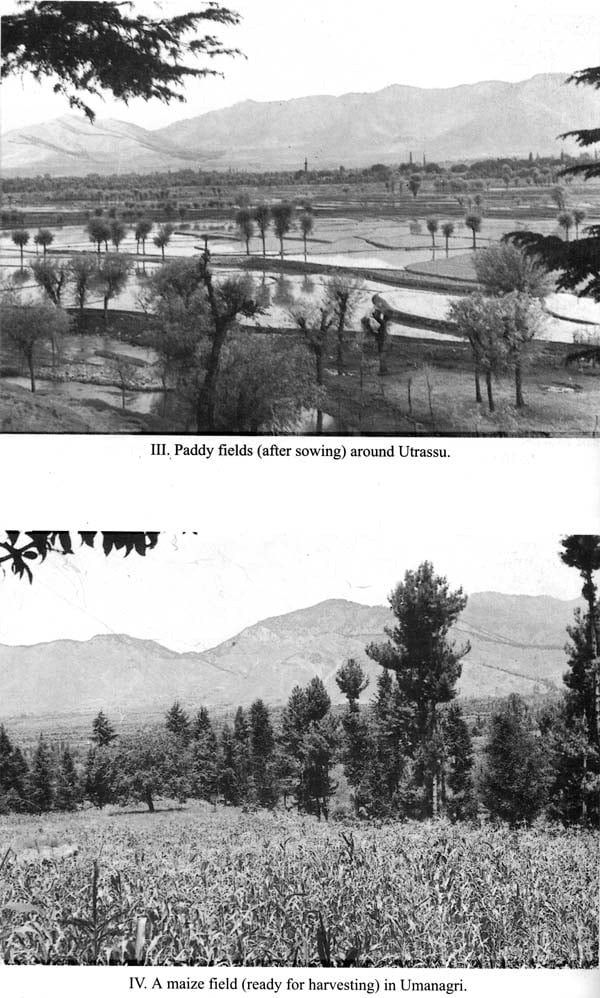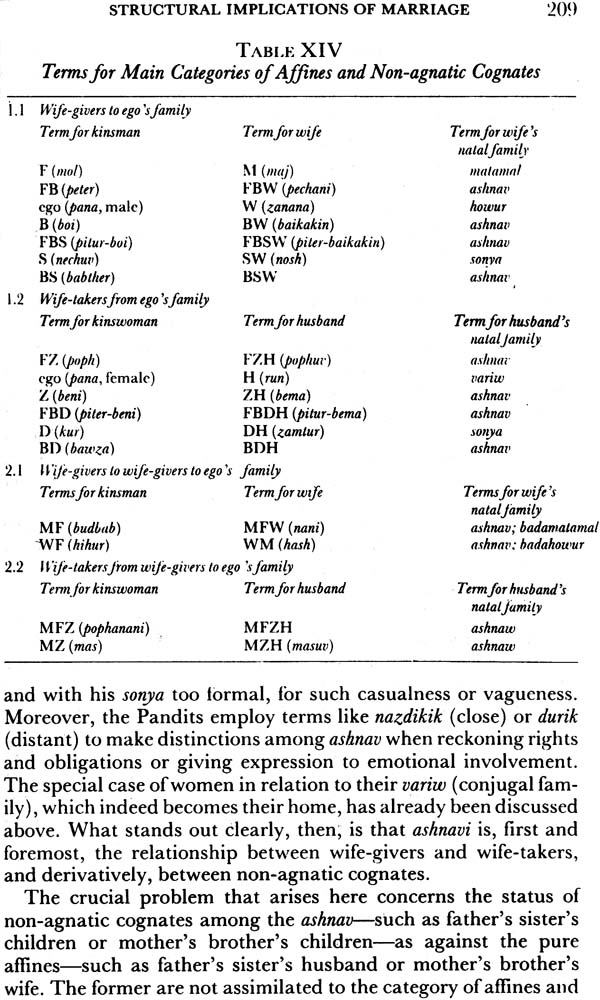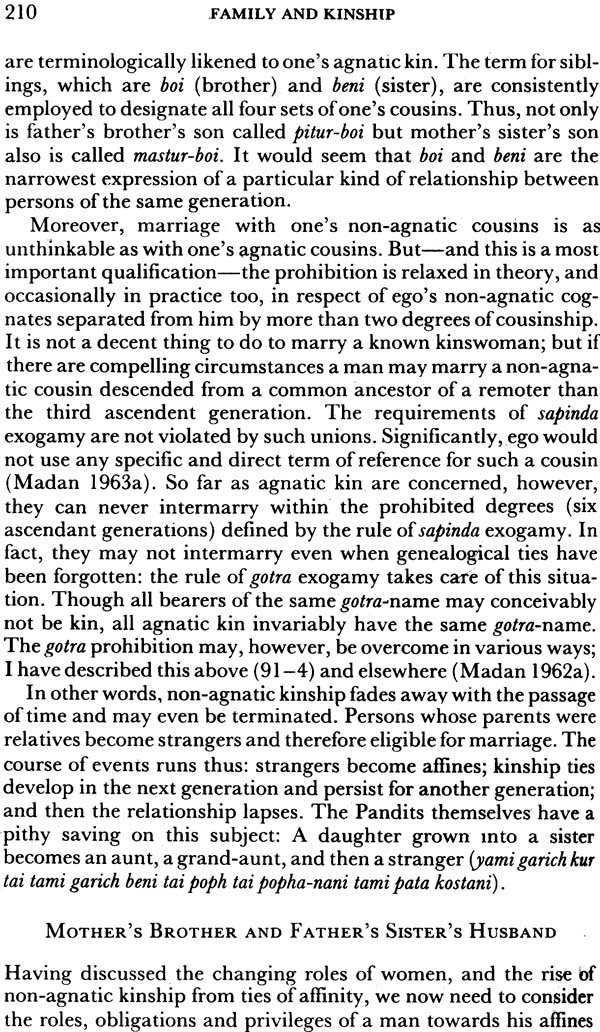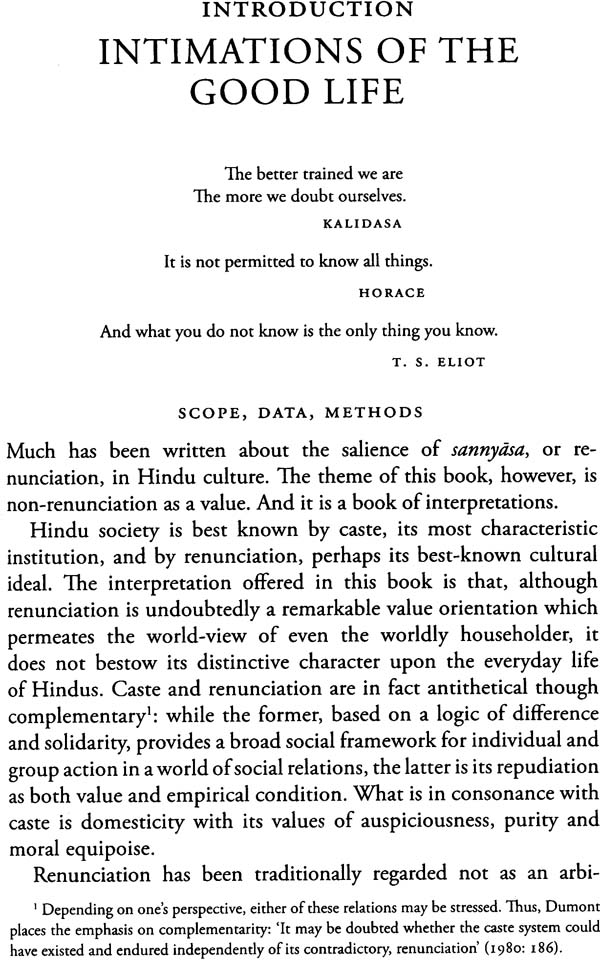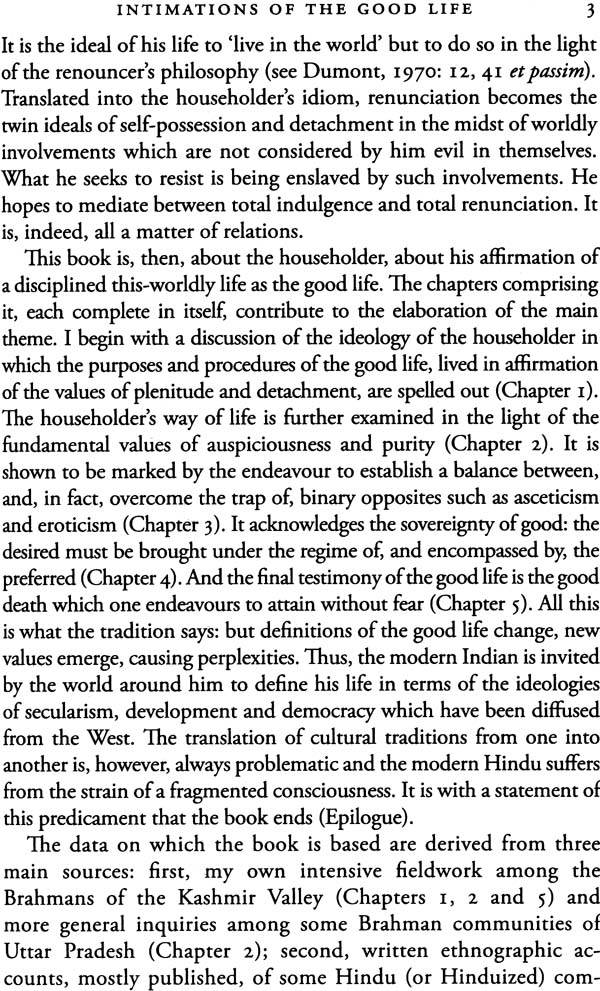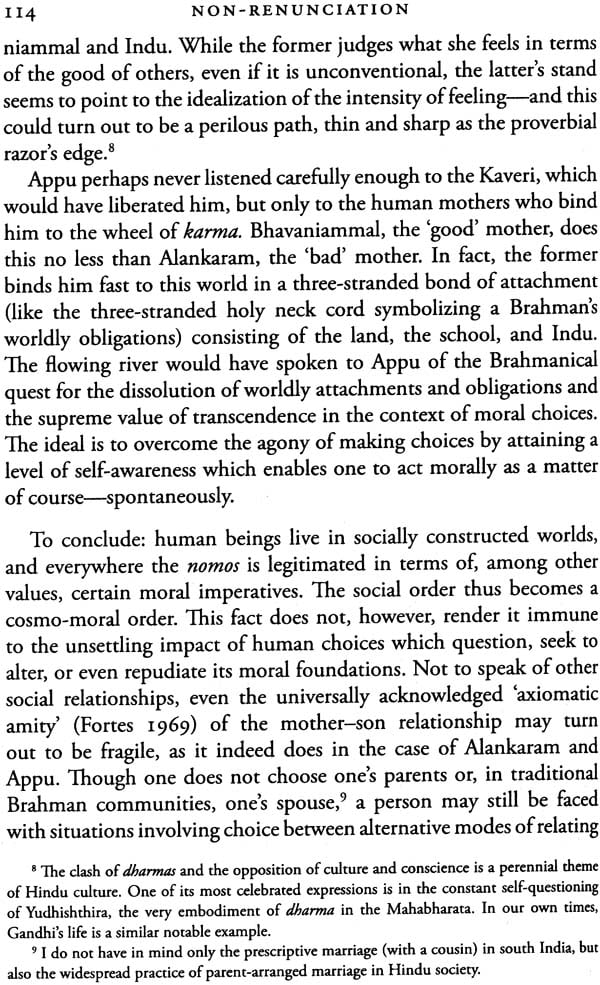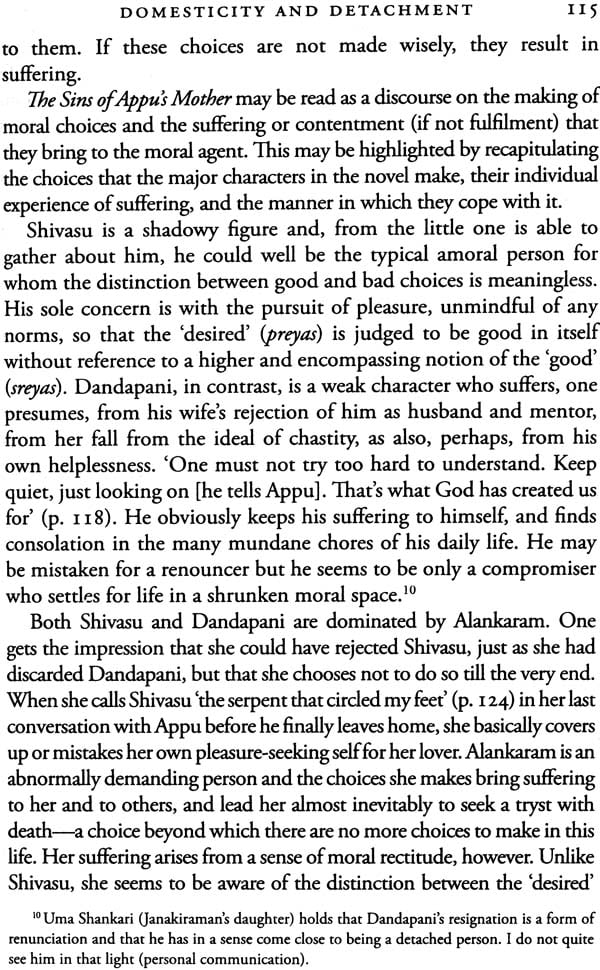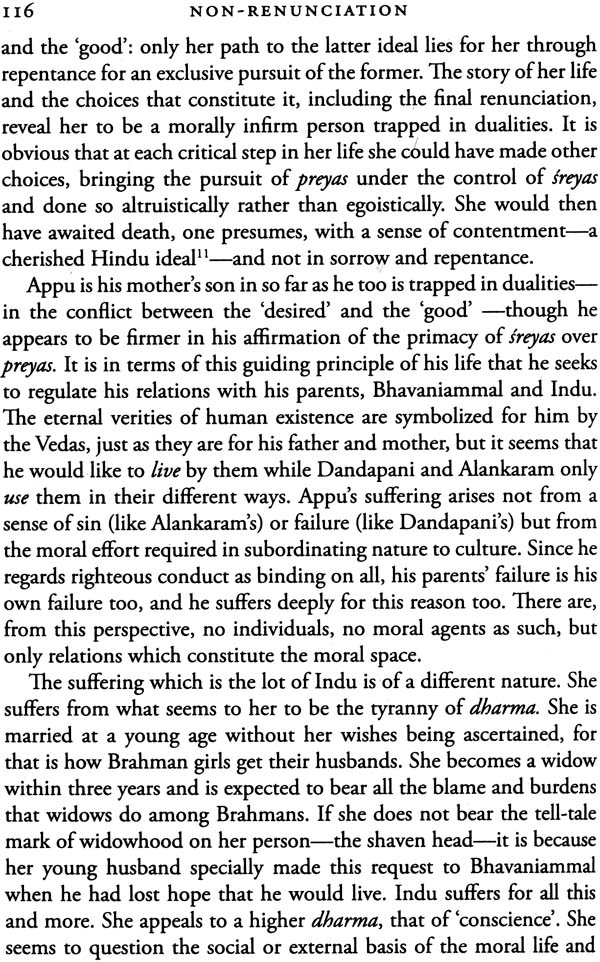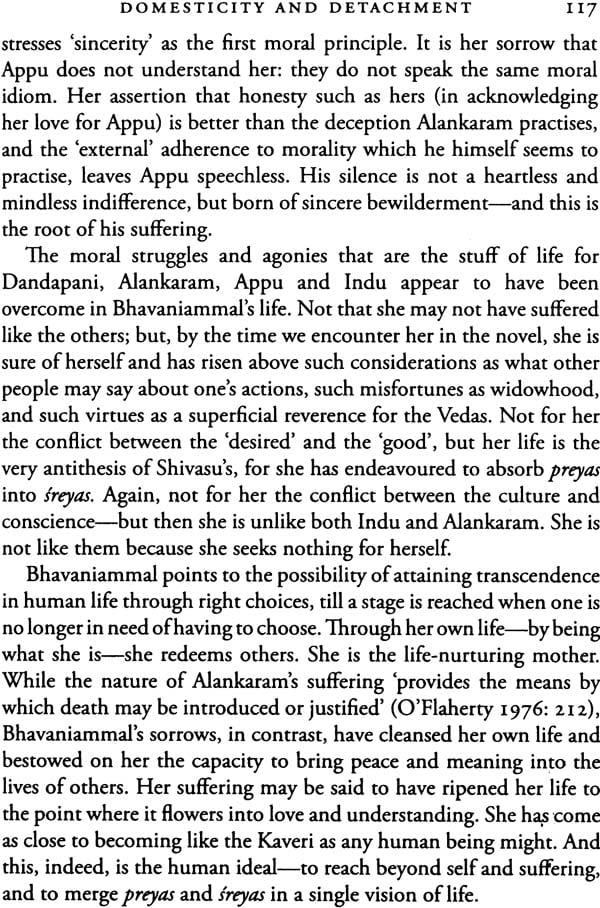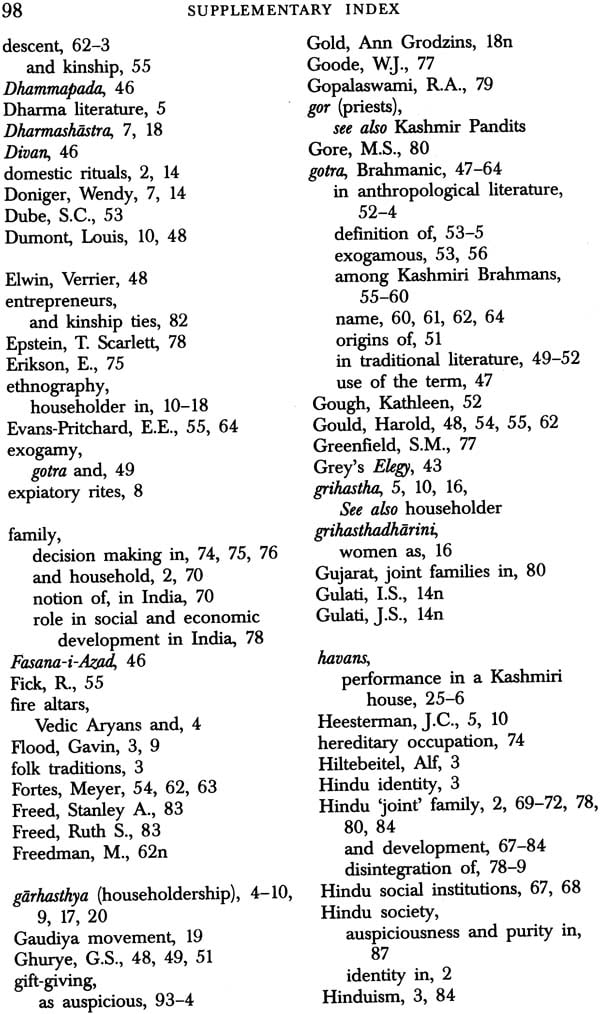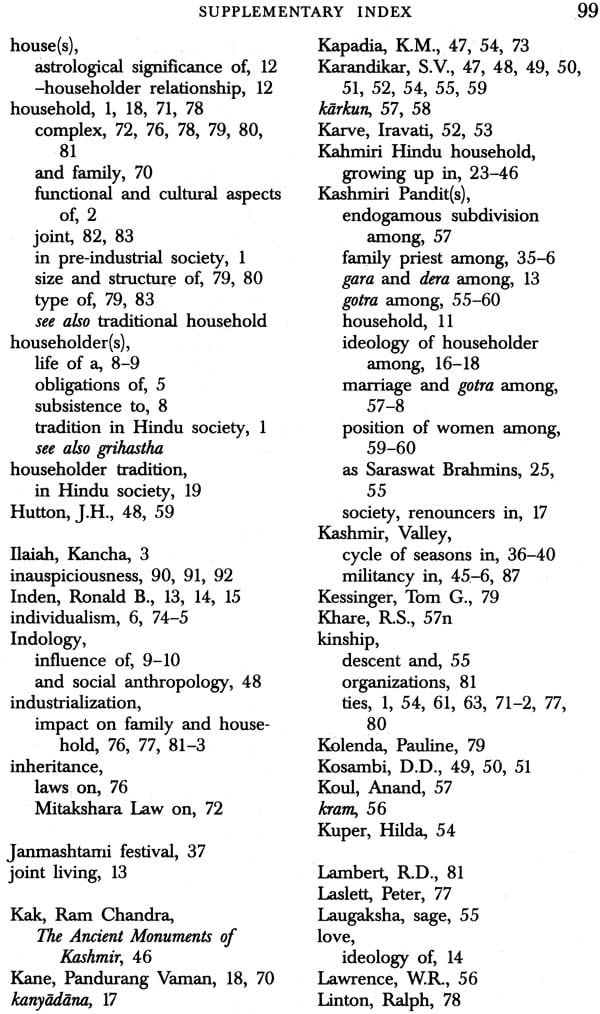
The T.N. Madan Omnibus -The Hindu Householder: Family and Kinship (A Study of the Pandit of Rular Kashmir) and Non-Renunciation (Themes and interpretations of Hindu Culture)
Book Specification
| Item Code: | NAL617 |
| Author: | T.N. Madan |
| Publisher: | Oxford University Press, New Delhi |
| Language: | English |
| Edition: | 2011 |
| ISBN: | 9780198069409 |
| Pages: | 676 (12 B/W Illustrations) |
| Cover: | Hardcover |
| Other Details | 9.0 inch x 6.0 inch |
| Weight | 830 gm |
Book Description
For more than half a century, T.N. Madan has been a towering influence on the sociological and anthropological studies of family and kinship, cultural dimensions of development, religion, secularism, and Hindu society and tradition. This Omnibus brings and Hindu society.
Family and kinship: A study of the pundits of rural Kashmir, first published in 1965, remains a pioneering ethnographic study of the Kashmiri pundits, and is considered a classic in the field of world anthropology. The book presents a social history of a people and culture which is currently virtually non-existent in the Kashmir Valley.
Drawing upon new theoretical and methodological perspectives, Non-renunciation: Themes and Interpretations of Hindu Culture provide a nuanced understanding of Hinduism as a lived tradition. It explores aspects of auspiciousness, purity, asceticism, eroticism, altruism, and death while focussing on the householder’s life in Hindu society.
The Omnibus also includes additional essay on the Brahmanic gotra, and the Hindu family and developments, along with a short piece on aspects of traditional household culture. It features an autobiographical essay-the author’s recollection of growing up in a pandit home in Srinagar, Kashmir. In the prologue, T.N Madan engages with the ‘householder tradition’ across the cultural regions of India, analysing themes of householder ship and renunciation in religious philosophy and ethnography. This collection will be indispensable to scholars and researchers of sociology, anthropology, and those with special interest in Kashmir pundits will find it illuminating.
T.N Madan is honorary professor (Sociology) at the Institute of Economic Growth, Delhi, and Distinguished Senior fellow distinguished senior fellow of the centre for the study of Developing Societies, Delhi. An elected fellow of the Royal Anthropological Institute, London, he is Docteur Honoris causa of the University of Paris (Nanterre),and a recipient of the Lifetime Achievement Award of the Indian Sociological society (2008).
The importance of the household in the study of society in India comes to be recognized in the late nineteenth century. For the census taker then, and since then, the household has been the concrete unit of social organization, so identified not only by the official enumerators but also by the people themselves. The fact that the house-household equation does not pose serious problems because the cultural emphasis was on the hearth or kitchen and the commensal group. Individuals as such did not matter, and kin grouping larger than the household were not easy to study because of their diffuse and fluid character. Among the Hindus generally ,but particularly among the upper castes, the individual was either a households(grithastha), In which case they lived in and through a households-based web of kinship and marriage ties and obligations, or a renouncer (sannyasi),in which case they lived outside the society. To say that the household is ‘the next bigger things on the social map after the individual’, as is often done in sociological literature, may make good sense elsewhere, but in India it is merely a truism.
What the census taker gained by way of concreteness or empirical validity, they regrettably squandered by getting bogged down in terminological confusions. A false or, in any case, misleading typological question emerged: is the joint family, believed to be characteristic of traditional of Indian societies, in decline? The debate used to rage furiously, and has not wholly petered out yet, although the size of the household, which was the census taker’s primary concern, remained almost constant for over a century. This confusion arose because the distinction between the family and the household was not clearly drawn by the outsiders (administrators as well as academics), although the people themselves were very surely aware of it.
Another reason for the failure or unwillingness to make this distinction earlier on was that anything bigger and more ramified that the so-called nuclear family, characteristic of Western Society, was seen as being not only a sign of cultural backwardness but also essentially unstable. Qualifying terms such as ‘joint’, ‘extended’, and ’undivided’ that came to be attached to the family in India, particularly among the Hindus, were and are, Quite misleading. Scholars such as Claude Levi-Strauss, in his famous essay on the family, could see this misconception as being clearly a matter of perspective: non-western, he pointed out, could well consider the typical western, nuclear family ‘restricted’, and not a cultural universal. Empirical studies, particularly those based on fieldwork, save us from many category assumptions, and are a sobering experience. While Indologists and sociologists of the earlier generations (Such as P.V. Kane and K.M. Kapadia, respectively) had given us description of the domestic domain on the basic of classical texts (such as the Manusmriti and the Epics) and other secondary sources, anthropologists turned from the traditional and the general to the contemporary and the specific, and rediscovered the importance of the household through fieldwork in villages and urban settlements. Their interest in the concrete was rooted in the ethnographic method: it was similar to but not the same as that of the census administrators.
Significant field studies of the family and the household ware contributed in the middle decades of twentieth century by a large number of scholars including I.P Dasai, M.S Gore, Pauline Kolenda, Ramkrishna Mukherjee , jyotirmoyee Sarma, Ursula M. Sharma, Milton singer, M.N Srinivas, Sylvia Vatuk, Susan Wadley and, most importantly ,A.M Shah(the Household Dimension of the family in India, Orient Longman, 1973). Not only were definitional issues discussed by these authors, the compositional and processual aspects of the households also in the context of economics and social development, particularly in urban areas, was studied closely. In the process, many dark corners of household life were illumined and many old myths about the negative impact of the joint family on modernization were exploded.
In the mid-1950s, I made an intensive fieldwork based study of the family and household among the pundits of rural Kashmir, and found that there was nothing outside or beyond the domestic domain in pandit society that it did not illumine. While extra-domestic kinship and marriage ties had obvious structural significance for it, everyday life everyday life was lived in all its vividness within the setting of the household. Economics activities and an emerging interest in politics also were rooted in the household and, to a lesser extent, in wider kin grouping and loyalties.
Family and Kinship: A study of the pundits of rural Kashmir was first published four and a half decades ago by Asia Publishing House from Bombay in 1965 and from London and New York the Following year. After remaining briefly out of print (because of a regrettable turn in the affairs of the publishing company), an enlarged second edition of the book came out from the Oxford University Press in 1989 and this has since been reprinted thrice. In Family and Kinship, the focus is on observable behaviour and, like all ethnography, it is local, a village study.
What was originally written as a contemporary account, with the focus on enduring structure rather than organizational change, has been transformed into a study of the past by a sudden and dramatic change in the fortunes of Kashmiri Pandits. The outbreak of violent, secessionist movements among the Muslims of the Valley in 1980-90 led their mass exodus. I have briefly mentioned these developments in the Preface to the second impression of the book. As I note there, another study of the Pandits of rural Kashmir will perhaps never be written because there are very few Pandits left in the valley. As of now (mid-2010), there is little hope of a sizeable number of the pandits returning to their homes and hearths.
After the completion of the writing of book, I published a number of research papers in professional journals and books. Some of these were based on continuing fieldwork in rural Kashmir, while others discursively explored broader themes highlighting the ideological dimension of the life of upper caste Hindu householders. One of the fieldwork-based papers, which drew upon the work of other anthropologists also, examined the structural implication of marriage in north India, and was reproduced as an appendix in the second edition of family and Kinship. Five other essays, two of them products of my fieldwork in Kashmir, and three, of library research, published over a decade, were brought together between the covers of a single volume, Non-renunciation: Themes and Interpretations of Hindu Culture, which was published by the Oxford University Press in 1987. this book has been reprinted three times and translated into French(A l’oppose du renouncement: Perplexities de la vie Quotidienne Hindoue, Edition Maison des Sciences de I’ Homme, Paris, 1990) and Hindi (Asannyas: Hindu Sanskriti, kucch Vishay, Kucch Vyakhayen, vani Prakashan, New Delhi, 2009).
Family and Kinship and Non-Renunciation are complementary works. While the former focuses on kashmiri Pandits, the latter reaches out, as it were to Brahman communities in other parts of the country; the former dwells at the micro level, the latter at the macro; the former is exclusively based on fieldwork, the latter draws data from several sources, including anthropological studies and work of fiction. The combined (Omnibus) edition of the two books is now being placed in the hands of readers, who will, I trust, appreciate the convenience of having and reading the two books together.
| Preface | xiii | |
| Publisher's Note | xviii | |
| Prologue:The Householder Tradition in Hindu Society | 1 | |
| | ||
| | ||
| Foreword | xiii | |
| Preface to the Second Paperback edition | xvii | |
| Preface to the Paperback Edition | xxiii | |
| Preface to the Second Edition | xxix | |
| Preface to the First Edition | xxxvi | |
| Acknowledgements | xxxvii | |
| 1 | Introdution:Problem and Methods | 1 |
| 2 | Kashmiri Pandits: History and Social Organization | 13 |
| 3 | Utrassu-Umanagri | 26 |
| 4 | The Homestead and the Household | 39 |
| 5 | Recruitment of the Households:(1) Birth and Adoption | 64 |
| 6 | Recruitment of the Households:(2)Marriage and Incorporation | 89 |
| 7 | The Economic Aspect of the Household | 126 |
| 8 | Partiton of the Household | 144 |
| 9 | The family and the Patrilineage | 159 |
| 10 | The Wider Kinship Structure: Non-Agnatic kin Bilateral filiation;The 'Matamal'Spouse's 'Matamal' Mother's Siblings;'Wora-Matamal';Parental 'Matamal';Non-agnatic Kinship | 183 |
| 11 | Household and the family among the pandits of rural Kasmir:Concluding Review | 192 |
| Appendix I | Stuctural Implication of Marriage:wife-gives and wife-takers The Problem;Women:Wives and Mothers;Ashnav:Affines and non-agnatic Cognaters;Mother's Brother and Father's sister's husband;Affinal Gifts:Wife-gives and Wife-takers;concluding Remarks | 201 |
| Appendix II | The Ideology of the Householder Introductory;Sociocultural Identity; 'Bhattil' and'Garhasthya';Selfhood and Personhood; External Signs of Pandit Identity;Pandit Identity:self-ascription;Parenthood:Biology and Morality;'Bhattil':Traditional Purposes of Lif | 230 |
| Appendix III | The Language of Kinship:(1) Kinship Terminology Treams of Reference;Ego's Generation;First Ascending Generation;Second and Third Ascending Genrations;First and Second Descending Generations;Ego's Affines;Terms of Address;Conclusion | 258 |
| Appendix IV | The Language of Kinship:(2) Proverbs Birth and Childhood;Marriages;Interpersonal Relation between Kin and affines | 266 |
| Appendix V | The 'Convoy':A Note on five Informants Sarwanand Pandit;Bishamber Nath koul;shambhu Nath tikoo;Vasadev Pandit;Srikanth Pandit | 270 |
| Appendix VI | On Living Intimately with Strangers Ethnographers and Natives; Beliefs and Rituals;The Private and the Public;Kinsfolk and Strangers;Conclusion-Outsiders and Insiders | 274 |
| Glossary | 297 | |
| References | 307 | |
| Index | 317 | |
| Non-Renunciation:Themes and Interpretations of Hindu Culture | ||
| preface | ix | |
| Acknowledgements | xi | |
| A Note on Translitertion | xiii | |
| Introduction:Intimations of the Good Life | 1 | |
| 1 | Domesticity and Detachment | 17 |
| 2 | Auspiciousness and Purity | 48 |
| 3 | Asceticism and Purity | 72 |
| 4 | The Desired and the Good | 101 |
| 5 | Living and Dying | 118 |
| Epilogue:The Quest for Hinduism | 142 | |
| Appendix:A Note on the Epigraphs | 169 | |
| References | 171 | |
| Index | 179 | |
| Epilogue:Growing Up in a Kashmiri Pandit Household | 23 | |
| Appandics | ||
| I | Is the Brahmanic Gotra a Grouping of Kin? | 47 |
| II | The Hindu Family and Development | 67 |
| III | Auspiciousness and Purity:Some Reconsiderations | 87 |
| Supplementary Index | 97 |
